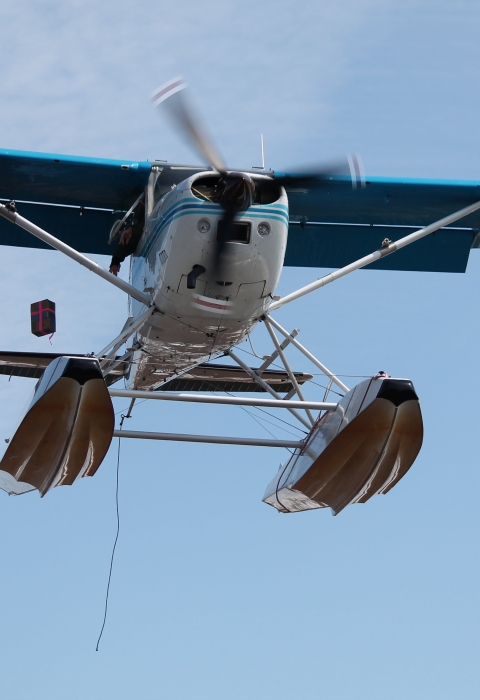What is the issue?
Collision between birds and planes is an issue that airports and air transportation agencies have been taking very seriously for some time now. These collisions between planes and birds are estimated to account for a small percentage of all bird deaths per year. The concern is largely that bird collisions with planes can compromise air travel safety.
Bird and other wildlife strikes to aircraft cause an estimated $900+ million in damage to U.S. civil and military aircraft annually. Furthermore, these strikes put the lives of aircraft crew members and their passengers at risk: over 250 people have been killed worldwide as a result of wildlife strikes since 1988.
To help track and analyze wildlife strike incidents, including but not limited to bird strikes, throughout the United States, the Federal Aviation Administration (FAA) developed a Wildlife Strike Report Database. From 1990 to 2013, 142,675 wildlife strikes were reported, 97 percent of which involved birds.
According to Bird Strike Committee USA, an organization that strives to reduce bird and other wildlife hazards to aircraft, three types of birds represent 75 percent of all reported bird strikes: waterfowl (31 percent), gulls (26 percent) and raptors (18 percent).
Why does this happen?
It goes without saying that birds and aircraft share our nation’s airspace, and the risk of collision with birds is a reality that needs to be taken seriously, especially with the increase in both the populations of large birds and aircraft traffic. Because planes fly at such high speed, the damage from collision with birds, especially large birds, or groups of birds that enter an engine or windshield, can be devastating. Although collisions between birds and airplanes can occur at any time, the majority are relatively low altitudes during take-off and landing. During flight, many planes, especially commercial jets, fly at higher altitudes than birds.
What are some solutions?
Airports implement a number of solutions to minimize risk of bird collisions with airplanes. The details of these are found in the FAA/APHIS Handbook "Wildlife Hazard Management at Airports: A Manual for Airport Personnel".
The overarching strategies in this Handbook are:
- Modification of aircraft flight schedules - Flight times can be altered to avoid periods when bird activity is known to be high and could be a threat. However, this strategy is typically not a practical option at large commercial airports.
- Habitat management - Changing the habitat around the airport to make it less attractive to birds that might pose a hazard may include reducing bird attractants like perches, carcasses, attractive habitat, and food sources. The Transportation Research Board (TRB) has developed a guidance document, TRB’s Airport Cooperative Research Program (ACRP) Synthesis 52: Habitat Management to Deter Wildlife at Airports, to help airport personnel implement effective habitat management measures to reduce bird collisions.
- Bird hazing - Non-lethal measures such as repellants or harassment techniques may include chasing birds away with dogs or falcons or playing loud sounds.
- Bird removal - In some cases, physical bird removal is the best option, especially when birds are nesting in the vicinity of an airport. For instance in the case of eagles, many airports work with the U.S. Fish & Wildlife Service to obtain a migratory bird permit to re-locate nests that pose a potential risk.
- Lethal control ;- At times, lethal removal of birds may be necessary. This can be done by obtaining a migratory bird permit from the U.S. Fish & Wildlife Service, and is often employed for species, such as Canada Geese, which occur in large aggregations and are difficult to remove by hazing or other tactics.
Radar and risk tools can also help pilots spot and avoid potential bird hazards. For instance, Doppler weather radar is increasingly used to spot bird activity along flight routes. In fact, radar has been used as a secondary layer along with modeled bird survey data to implement the Avian Hazard Advisory System (AHAS) that pilots use to evaluate potential flight collision risk in an area.
The U.S. Department of Agriculture, Animal Plant Health Inspection Service’s (USDA-APHIS) Wildlife Services division plays a key role in helping minimize human-avian interactions at airports by developing management tools to reduce bird strike hazards, and providing Wildlife Services biologists, airport personnel, and FAA officials with information on the latest strategies for controlling wildlife hazards.
For more information about measures and guidance for avoiding or minimizing impacts to migratory birds, please visit the Conservation Measures and Guidance Documents webpages.
Material on this webpage was sourced from: Dolbeer 2015, http://www.birdstrike.org/ (accessed 3/17/16), http://wildlife.faa.gov/default.aspx (accessed 3/17/16), Cleary and Dolbeer 2005



